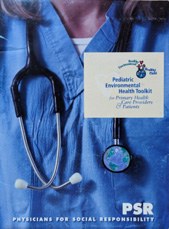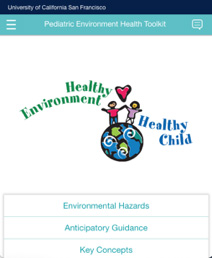About Version 3 of the Pediatric Environmental Health: e-Toolkit for Prevention (PEHT)
Revised February 2023
The Toolkit is an easy-to-use reference guide for health providers on preventing exposures to toxic chemicals and other substances that affect infant and child health. This mobile-ready e-Toolkit includes links to many related online resources, and is designed to be easy for health providers to access on the go.
The 2023 redesign of the PEHT includes updates throughout, material on topics not previously covered, a modernized user experience, and a framework that allows busy clinicians to access information in whatever way is most relevant for a given patient encounter .
This revision of the Pediatric Environmental Health: e-Toolkit for Prevention was supported by the American Academy of Pediatrics (AAP) and funded (in part) by a cooperative agreement with the Centers for Disease Control and Prevention/Agency for Toxic Substances and Disease Registry (CDC/ATSDR) and the UCSF Environmental Research and Translation for Health (EaRTH) Center via the core center grant P30-ES030284 from the National Institute of Environmental Health Sciences, National Institutes of Health. The U.S. Environmental Protection Agency (EPA) supports the PEHSUs by providing partial funding to CDC/ATSDR through an Inter-Agency Agreement. The findings and conclusions presented have not been formally disseminated by CDC/ATSDR, NIEHS, or EPA and should not be construed to represent any agency determination or policy. Use of trade names that may be mentioned is for identification only and does not imply endorsement by the CDC/ATSDR, NIEHS, or EPA.
Thank you to all of those involved in Version 3 of the PEHT!
Project Leads: Stephanie Holm MD, PhD, MPH, Mark Miller MD, MPH
Section Authors:
Laura Anderko, PhD, RN
Rose Goldman, MD, MPH
Sam Goldman, MD, MPH
Catherine Karr, MD, PhD, MS
Stacy Laurent, DO
Bianka Martinez, DO
Ruth McDermott-Levy, PhD, MPH, RN, FAAN
Aditi Mhaskar, MD, MPH
Nicholas Newman, DO, MS, FAAP
James Earl Schier Nolan, MPH
Maria Valenti
Marya Zlatnik, MD, MMS
Peer Reviewers:
Mark Anderson, MD
Susan Buchanan, MD, MPH
MaryKate Cardon, DNP, CPNP-PC
Diana Felton, MD, FACEP
Elizabeth J. Friedman, MD, MPH
Marissa Hauptman, MD, MPH, FAAP
Catherine Karr, MD, PhD, MS
Gary Loy, MD, MPH
Ruth McDermott-Levy, PhD, MPH, RN, FAAN
Kimberly Manning, MA
Stormy Monks, PhD, MPH, CHES
Abby Mutic, PhD, MSN, CNM
Nicholas Newman, DO, MS, FAAP
Isadore Leslie Rubin, MD
Sheela Sathyanarayana, MD, MPH
Lauren Zajac, MD, MPH
First Edition of the Pediatric Environmental Health Toolkit (2006, printed)
Thank you to the Greater Boston (GBPSR) and San Francisco Bay Area chapters of Physicians for Social Responsibility, members of the AAP California Chapter 1 Environmental Health Committee, and several pediatricians from around the country, who contributed to the first edition of the PEHT in collaboration with the Western States Pediatric Environmental Health Specialty Unit. Funding provided by the Orch Contributors and reviewers: Mark Miller, Lisa Asta, Marybeth Dunn, Michelle Gottlieb, Guenter Hofstadler, Brian Linde, Siobhan McNally, Lucia Sayre, Kathy M. Shea, Gina Solomon, Maria Valenti, David Wallinga


Second Edition of the Pediatric Environmental Health Toolkit (2016, online)
This popular material was updated by a team of Pediatric Environmental Health Specialty Unit faculty with Physicians for Social Responsibility for this mobile device ready version. Additional funding was provided from the UCSF Office of Sustainability, the UCSF 2015-2016 Toxics Reduction work group, the Rose Foundation, the American College of Medical Toxicology, EPA and ATSDR. Contributors and reviewers: Mark Miller, Laura Anderko, Nancy Beaudet, Stephen Borron, John Chiosi, Marybeth Dunn, Timur Durrani, Scott Everson, Maida Galvez, Robert Geller, Rose Goldman, Catherine Karr, Jennifer Lowry, Leslie Maness, Beth Neary, Nicholas Newman, Trish O’Day, Ada Otter, Jerry Paulson, Natasha Ramsey, Leslie Rubin, Sheela Sathyanarayana, Perry Sheffield, Alan Taylor, Raisa Tikhtman, Maria Valenti, Margaret Willis, Lauren Zajac
For questions, concerns or feedback concerning this web based mobile application contact:
Western States Pediatric Environmental Health Specialty Unit - San Francisco, California
Email: pehsu@ucsf.edu
Website: https://wspehsu.ucsf.edu
For medical information and advice on environmental conditions that influence reproductive and children's health, refer to your regional Pediatric Environmental Health Specialty Unit.
https://www.PEHSU.net
The contents of this site are for informational purposes only.
No content is intended to be a substitute for professional medical judgment or advice, diagnosis, or treatment. The state of knowledge regarding the treatment of patients potentially exposed to hazardous substances in the environment is constantly evolving and is often uncertain. In developing these educational products we have made a diligent effort to ensure the accuracy and the currency of the presented information. However, the PEHT developers make no claim that the PEHT materials comprehensively address all possible situations related to various substances. These are intended for educational use to build the knowledge of health professionals in assessing the conditions related to and providing anticipatory guidance about children’s exposures to hazardous substances.
Always seek the advice of a physician or other qualified health care professional with any questions you may have regarding any medical condition. Never disregard or delay in seeking medical advice based upon something that you have read on this site. If you think you may have a medical emergency, call 911 or a qualified health care professional. Reliance on any information provided on this site is solely at your own risk.

